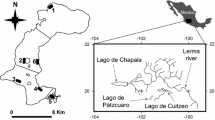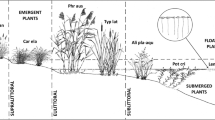Abstract
In Mexico, as in many other subtropical and tropical countries, there has been a recent trend towards stocking non-native carp (Cyprinus carpio) in lakes and ponds as a source of food in rural areas. However, the results of a study in a series of small(1–8 ha.), shallow (<2 m), semi-natural ponds in Acambay, a high altitude valley in the basin of the Lerma river in the volcanic belt in central west Mexico, illustrate that the stocking of carp over a threshold value may have a detrimental ecological impact at several trophic levels. Ponds with carp tended to be turbid with high levels of suspended solids, and with few rooted macrophytes and epibenthic invertebrates. In contrast, ponds without carp had clear water and abundant rooted macrophytes and associated invertebrates, particularly gastropod molluscs. The direct uprooting of macrophytes by benthic foraging carp appeared to be the most important mechanism in switching the ponds from a clear macrophyte-dominated to a turbid state. The subtropical study ponds thus appear to confirm the alternative stable-state hypothesis developed intemperate lakes, although the importance of benthic rather than pelagic interactions was emphasised. The implications of stocking carp for native fauna of high intrinsic conservation value and as a food supply for local people are outlined.
Similar content being viewed by others
References
APHA (American Publish Health Association), 1985. Standard Methods for the Examination of Water and Wastewater, 16th edn. Amer. Pub. Health. Assoc., Washington. D.C.
Bazzanti, M., S. Baldoni & M. Seminara, 1996. Invertebrate macrofauna of a temporary pond in central Italy-composition, community parameters and temporal succession. Arch. Hydrobiol. 137: 77–94.
Breukelaar, A., E. Lammens, J.G.P. Klein Breteler & I. Tatrai, 1994. Effects of benthivorous bream (Abramis brama) and carp (Cyprinus carpio) on sediment resuspension and concentrations of nutrients and chlorophyll a. Freshwat. Biol. 32: 112–121.
Bronmark, C. & S.E.B. Weisner, 1992. Indirect effects of fish community structure on submerged vegetation in shallow, eutrophic lakes: An alternative mechanism. Hydrobiologia 243/244 (Dev. Hydrobiol. 79): 293–301.
Brumley, A.R., 1991. Cyprinids of Australasia. In: Winfield I.J. & J.S. Nelson (eds), Cyprinid Fishes-Systematics, Biology and Exploitation. Fish & Fisheries Series 3. Chapman & Hall, Ltd., London.
Cahn, A.R., 1929. The effect of carp on a small lake: The carp as dominant. Ecology 10: 37–374.
Carvalho, L. & B. Moss, 1995. The current status of a sample of English Sites of Special Scientific Interest subject to eutrophication. Aquat. Conserv: Mar. Freshwat. Ecosyst. 5(3): 191–204.
Carpenter, S.R., J.F. Kitchell, J.F. Hodgson, P.A. Cocharn, J.J. Elser, M.M. Elser, D.M. Lodge, D. Kretchmer, X. He & C.N. Von Ende, 1987. Regulation of lake primary productivity food web structure. Ecology. 68: 1863–1876.
Cline, J.M., T.L. East & S.T. Threlkeld, 1994. Fish interactions with the sediment–water interface. Hydrobiologia 275/276 (Dev. Hydrobiol. 94): 301–3012.
Crisman, T.L. & R.J. Beaver, 1990. Applicability of planktonic biomanipulation for managing eutrophication in the subtropics. Hydrobiologia 200/201 (Dev. Hydrobiol. 61): 177–183.
Crowder, A. & D.S. Painter, 1991. Submerged macrophytes in Lake Ontario: Current knowledge importance, threats to stability, and needed studies. Can. J. Fish. Aquat. Sci. 48(8): 1539–1545.
DGN, 1986. Método Sulfato Brusina para determinar Nitratos. NMX-AA-79-1986. Dirección General de Normas, SECOFI, México.
Dumont, H.J., 1994. On the diversity of the Cladocera in the tropics. Hydrobiologia 272: 27–38.
Espinoza, P.H., D. Gaspar & M. P. Fuentes, 1993. Listados faunísticos de México III, los peces dulceacuícolas mexicanos. Instituto de Biología, UNAM, México.
Fernando, C.H., 1991. Impacts of fish introductions in Tropical Asia and America. Can. J. Fish. Aquat. Sci. 48: 24–32.
Fernando, C.H., 1994. Zooplankton, fish and fisheries in tropical fresh-waters. Hydrobiologia 272: 105–123.
García, E., 1988. Modificaciones al sistema de clasificación climática de Köppen. México.
Gliwicz, Z.M., 1994. Relative significance of direct and indirect effects of predation by planktivorous fish on zooplankton. Hydrobiologia 272: 201–210.
James, W.F. & J.W. Barko, 1990. Macrophyte influences on the zonation of sediment accretion and composition in a north-temperate reservoir. Arch. Hydrobiol. 2: 129–142.
Jeppesen, E., J.P. Jensen, M. Søndergaard, T. Laurisdsen, L.J. Pedersen & L. Jensen, 1997. Top down control in freshwater lakes: The role of fish, submerged macrophytes and water depth. Hydrobiologia 342/343 (Dev. Hydrobiol. 119): 151–164.
Irvine, K., B. Moss & H. Balls, 1989. The loss of submerged plants with eutrophication II. Relationships between fish and zooplankton in a set of experimental ponds, and conclusions. Freshwater Biology 22: 89–107.
Ivlev, V.S., 1961. Experimental Ecology of the Feeding of Fishes (Transl. by D. Scott). New Haven, Yale University Press.
Kalff, J. & S. Watson, 1986. Phytoplankton and its dynamics in two tropical lakes: A tropical and temperate zone comparison. Hydrobiologia 138 (Dev. Hydrobiol. 33): 161–176.
Kolasa, J. & L. Weber, 1995. Relationship between the spatial scale an biotic variability in a wetland ecotone. Hydrobiologia 303: 61–67.
Lammens, E.H.R.R. & W. Hoogenboezem, 1991. Diets and feeding behaviour. In: I.J. Winfield & J.S. Nelson (eds), Cyprinid Fishes-Systematics, Biology and Exploitation. Fish and Fisheries Series 3. Chapman & Hall., Ltd., London.
Lewis, W.M. Jr., 1990. Comparisons of phytoplankton biomass in temperate and tropical lakes. Limnol. Oceanogr. 35: 1838–1845.
Lorenzen, C.J., 1966. A method for the continuous measurement of in vivochlorophyll concentrations. Deep-Sea Research 13: 223–227.
Matveev, V., C.C. Martinez, S.M. Frutos & Y. Zalocar De Domitrovic, 1992. Population control in planktonic crustaceans of a subtropical lake during seasonal succession. Arch. Hydrobiol. 124: 1–18.
Maitland, P.S. & R.N. Campbell, 1992. Freshwater Fishes. Harper Collins Publishers, London.
Meijer, M.-L., M.W. De Hann, A.W. Breukelaar & H. Buitveld, 1990. Is reduction of the benthivorous fish an important case of high transparency following biomanipulation in shallow lakes? Hydrobiologia 200/201 (Dev. Hydrobiol. 61): 303–315.
Moss, B., J. Stansfield, K. Irvine, M.R. Perrow & G.L. Phillips, 1996. Progressive restoration of a shallow lake: A 12-year experiment in isolation, sediment removal and biomanipulation. J. Applied. Ecology 33: 71–86.
Necchi, O. Jr., L.H.Z. Branco & C.C.Z. Branco, 1995. Comparison of three techniques for estimating periphyton abundance in bedrock streams. Arch. Hydrobiol. 134: 393–402.
Perrow, M.R., M.-L. Meijer, P. Dawidowicz & H. Coops, 1997. Biomanipulation in shallow lakes: State of the art. Hydrobiologia 342/343 (Dev. Hydrobiol. 119): 355–365.
Ramirez-Herrera, M.T., M.A. Summerfield & M.A. Ortiz-Pérez, 1994. Tectonic geomorphology of the Acambay graben, Mexican Volcanic Belt. Z. Geomorph. N. F. 38: 151–168.
Renfro, W., 1962. Small beam net for sampling postlarval shrimp. Galveston Biological Lab. June 30. U.S. Fish and Wild. Serv. Circ. 161: 86–87.
Richardson, M.J., F.G. Whoriskey & L.H. Roy, 1995. Turbidity generation and biological impacts of an exotic fish Carassiusauratus, introduced into shallow seasonally anoxic ponds. J. Fish Biol. 47: 576–585.
Scheffer, M., 1998. Ecology of Shallow Lakes. Chapman & Hall, London.
Scheffer, M., S.H. Hosper, M.-L. Meijer, B. Moss & E. Jeppesen, 1993. Alternative equilibria in shallow lakes. TREE 8: 275–279.
Siegel, S. & J.N. Castellan Jr., 1988. Nonparametric Statistic for Behavioral Sciences. McGraw-Hill International Editions, 399 pp.
Stansfield, J.H., M.R. Perrow, L.D. Tench, A.J.D. Jowitt & A.A.L. Taylor, 1997. Submerged macrophytes as refuges for grazing Cladocera against fish predation: Observations on seasonal changes in relation to macrophyte cover and predation pressure. Hydrobiologia 342/343 (Dev. Hydrobiol. 119): 229–240.
Szumiec, M.A., 1989. The role of carp, temperature and morphometry in solar radiation transmission in ponds. Arch. Hydrobiol. Beih. Ergebn. Limnol. 33: 571–577.
Tatrai, I. & V. Istvanovics, 1986. The role of fish in the regulation of nutrient cycling in Lake Balaton, Hungary. Freshwat. Biol. 16: 417–424.
Tatrai, I., G. Toth, J.E. Ponyi, J. Zlinskzky & V. Istvanovics, 1990. Bottom-up effects of bream (Abramis bramaL.) in Lake Balaton. Hydrobiologia 200/201 (Dev. Hydrobiol. 61): 167–175.
Tatrai, I., E.H.R.R. Lammens, A.W. Breukelaar & J.G.P. Klein Breteler, 1994. The impact of mature cyprinid fish on the composition and biomass of benthic macroinvertebrates. Arch. Hydrobiol. 131: 309–320.
Ten Winkel, T.E.H. & J.T. Meulemans, 1984. Effects of fish upon submerged vegetation. Hydrobiol. Bull. 18: 157–158.
Wetzel, R.G., 1983. Limnology. Saunders College Publishing, USA.
Author information
Authors and Affiliations
Rights and permissions
About this article
Cite this article
Zambrano, L., Perrow, M.R., Macías-García, C. et al. Impact of introduced carp (Cyprinus carpio)in subtropical shallow ponds in Central Mexico. Journal of Aquatic Ecosystem Stress and Recovery 6, 281–288 (1998). https://doi.org/10.1023/A:1009958914016
Issue Date:
DOI: https://doi.org/10.1023/A:1009958914016




